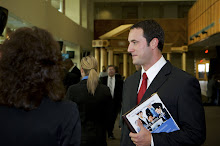Chad Pinkston http://www.thecorporateplaybook.com
From: The Hiring Site <ideas@careerbuilder.com>
Date: Tue, 22 Dec 2009 03:46:25 +0000
To: <cpinkston@thecorporateplaybook.com>
Subject: The Hiring Site
| The Annual Review: 2009’s Top 10 Workplace Trends Posted: 21 Dec 2009 05:34 PM PST  The year is almost over, which of course means it's time for a completely unprecedented, unexpected-in-every-way "top 10 of 2009" list… The year is almost over, which of course means it's time for a completely unprecedented, unexpected-in-every-way "top 10 of 2009" list…
Here, I give you my list of the 10 biggest trends we saw this year in the world of workforce management. (Notice anything I missed? Let me know in the comments section below!) - Social Media Specialists made their way to corporate America. Recognizing the value in using social media as both a branding and recruiting tool, companies like Comcast, General Motors and JetBlue Airways, began hiring professionals specifically for the sake of managing and monitoring their social media sites. (Even Britney Spears got in on the action.)
- Internships made a comeback…in various forms. In the tightened economy, internship positions became more competitive among job seekers– as well as an attractive alternative for employers looking for cheap labor and a way to "test" new employees before hiring them full-time. One position that stood out was Pizza Hut's "Twintern," an intern responsible for posting updates on – and monitoring – the company's Twitter account. The experiment turned out to be a success on both ends – come fall, Pizza Hut offered the twintern a full-time position. Similarly, 2009 also saw the rise of virtual internships made possible through improving technology and the growth of social media, and enabling employers to expand their pool of candidates while saving money on office overhead.
- Older workers were forced to rethink retirement. Nearly 60 percent of workers aged 65 and older reported that they were postponing retirement due to financial strains, according to a March 2009 CareerBuilder survey. While employers may be worried over how they will manage this aging workforce, multigenerational workforces are actually an asset to employers; they simply need to be "proactive in devising new strategies to harness and harmonize the multigenerational workforce," advises BusinessWeek's Roselyn Feinsod.
- "Qwittered" entered the American lexicon…joining the prestigious ranks "Facebook fired." Stories abounded this year of employees getting reprimanded for posting inappropriate comments or – as we saw in this year's most infamous case - videos on online social media sites. Even celebrities were not immune to this trend, as ESPN's Sports Guy recently found out. What can we learn from these stories? For one thing, having a well-thought out and clearly stated social media policy in place can eliminate these sorts of incidents. Make sure employees are aware of the policy and that what they say can be grounds for punishment. (For tips on creating a social media policy, check out Sharlyn Lauby's excellent post on 10 Must-Haves for Your Social Media Policy)
- Medical cost-cutting efforts got more creative. As health care costs soared, businesses began looking for ways to reduce medical coverage expenses with a new sense of urgency. Whole Foods, for instance, began offering workers incentives for losing weight and improving their overall health to ultimately reduce medical coverage costs; while other employers started expanding their employee assistance program offerings to include counseling – a less expensive alternative to therapy obtained through company medical coverage… Then of course there were those companies making the case for legalizing medical marijuana, saying the move could save them money on drug costs.
- Thursday became the new Friday. Taking a cue from Utah’s institution of a four-day workweek for state workers, employers nationwide began to follow suit – hoping to generate the same benefits Utah saw as a result of its experiment. Not only did the state successfully reduce energy and help workers save money on commuting costs, as it had hoped, but workers took fewer sick days and state services improved, as well.
- Women made workplace history. As layoffs hit men at a disproportionate rate, the ratio of women to men in the workforce evened out. As of September, women held half of the nation's jobs – for the first time in our nation's history.
- Sex at the office became a hot(ter?) topic: While sex in the workplace is nothing new, the debate – both in the media and at the water cooler – over if and when it's ever okay reignited after David Letterman admitted to having an affair with a "Late Night" staffer – and gained even more steam when two other, high profile sex-in-the-workplace stories surfaced soon after. (Regardless of where you stand on the issue, it's always good to have a refresher on the rules regarding sex in the workplace.)
- Year-end bonuses, gifts and holiday parties disappeared. No surprises here: Fewer businesses planned office parties this year – whether due to budget concerns, or out of mindfulness of the hardships clients and employees' families are experiencing. In the spirit of the season, however, some employers are organizing company-wide charitable events as an alternative. As is the case with holiday parties, the economy is also preventing many businesses from offering the typical year-end gifts or grant bonuses…but that doesn't mean they're not trying to appease their employees and clients with alternative gifts, such as car washes, choice parking spots and complimentary breakfasts.
- Office personal space became scarcer. In efforts to trim costs and boost productivity, many employers nationwide began reducing per-employee office space – from removing cubicle walls to create open floor plans, to eliminating assigned workspaces for employees who spend a lot of time away from their desks. Despite employers’ good intentions, however, some employees are finding that the closer quarters disrupt their work flow and increase tensions, according to the Wall Street Journal. (The lesson? Know your audience: While some people may thrive in tighter quarters, it can be distracting to others. Help your employees by giving them the option to work remotely or make sure you arrange the office in a way that maximizes the available space.)
What trends did you notice popping up this year? (And what do you anticipate we’ll see more or less of in 2010?)  |





No comments:
Post a Comment